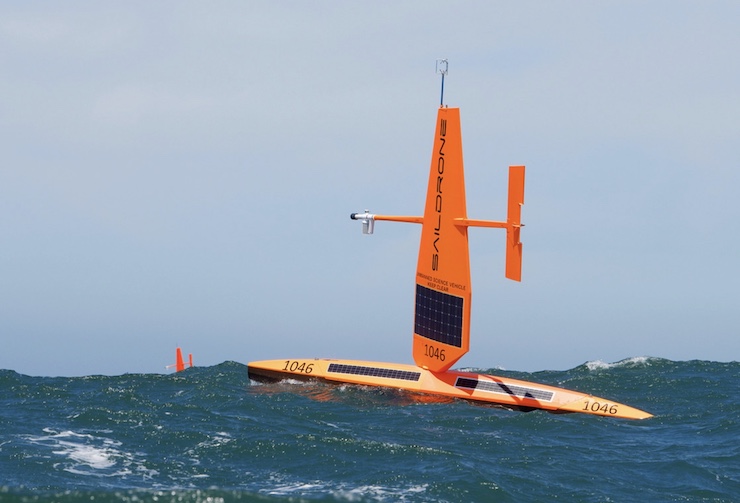Drone Company, “Saildrones” Using Water Drones To See How Oceans Influence the Weather

© Saildrone
Oceans support nearly all life on Earth in one way or another. One of the biggest ways the oceans affect our planet is by creating weather patterns. As the largest bodies of water, ocean currents regulate climate, which in turn determines weather patterns. This could be anything from temperature changes, wind, mild rain or snow, and even extreme weather systems like hurricanes and tsunamis. Understanding how the oceans influence weather is important for day to day life. Still, because of the vastness of the oceans, being able to study them has never been easy.
In 2009, Richard Jenkins broke the land speed record for wind-powered vehicles in Nevada reaching 126.2mph with his patented wing technology. After spending 10 years perfecting this technology and breaking the record, Richard moved to San Fransisco to apply his methods to unmanned vehicles that could be used to collect highly valuable data. In 2012, Richard founded Saildrone, a company that creates cost effective oceanic drones that are solar and wind-powered. Richard’s drones have gone on to become one of the most trusted ways of conducting remote ocean research. As stated by Saildrone, “Saildrone vehicles collect data that provides unprecedented intelligence for climate, mapping, and maritime security applications and have sailed over 500,000 nautical miles and spent more than 13,000 days at sea.”
In May of 2021, Samantha Wills, Meghan Cronin, and Dongxiao Zhang published a paper explaining how Saildrones were aiding in critical oceanic research. The title of the paper is “Cold Pools Observed by Uncrewed Surface Vehicles in the Central and Eastern Tropical Pacific”. Cold pools develop in pockets of air under thunderstorms. These air masses can range between 10-200 kilometers in diameter. When they hit the ocean surface, the cold pools can create drastic temperature fronts that can greatly change environmental weather patterns. However, scientists know relatively little about how cold pools affect the atmosphere on a larger scale because being able to study them is not safe from a crewed vessel.
With drones, being able to collect data from dangerous or remote places is now achievable. Samantha and her team conducted three 6 month long missions using Saildrones to collect data from cold pools in remote regions of the tropics. They used 10 drones in total that covered a combined distance of 137,000 kilometers of the Pacific Ocean. The drones were able to collect data from 382 cold pool events. The drones were equipped with a wide range of sensors to give the team multiple study points.
During the study, the Saildrones collected data on atmospheric temperature, humidity, wind speed, and pressure. The drones also collected ocean surface readings on temperature and salinity. In one of the tests, 4 Saildrones were positioned within several kilometers of each other surrounding a TAO (Tropical Atmosphere Ocean) buoy. The drones worked together with the TAO to capture minute by minute data on how a cold pool forms, progresses and changes the atmospheric pressure.
The results from this study prove that drones can safely and cost effectively gather data on weather patterns in remote regions. This data can then be used to shape weather prediction models for increased accurate forecasting. With this information, people can be more prepared for some of the extreme weather events that frequently occur in tropical regions. Samantha and her team found that using drones to access this data was invaluable and can have numerous applications. The team is already planning further research missions with Saildrone.
|